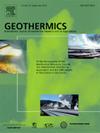青藏高原东南部咸水河断裂带热液系统的热预算:对地热积聚过程的启示
IF 3.5
2区 工程技术
Q3 ENERGY & FUELS
引用次数: 0
摘要
断层带的行为与温度、压力、岩石特征和流体活动有关,而传热过程对断层的动态行为起着至关重要的作用。然而,活动造山带中大型走向滑动断层的热特征尚不清楚。本研究利用纯传导、降雨渗透、地下水排泄和摩擦加热四要素模型构建了咸水河断裂带热预算模型,计算了研究区不同深度的不同热通量。分析了热通量的空间特征和随深度的变化。结果表明,研究区域的地表热通量约为 22 W/m²,与土壤热通量测量结果一致。在热通量模型中,降雨对流和地下水排放是热传递的主要控制因素,分别贡献了 9.84 W/m² 和 8.67 W/m²。这两部分占浅层(1-3 千米)地表热通量的 80%以上。纯传导产生的热量约为 0.16 瓦/平方米,约占总热量的 1%,而摩擦加热模型产生的表面热通量为 3.13 瓦/平方米,约占总热量的 14%。在深度超过 9 千米的地方,摩擦热量不断增加,所占比例超过 95%,是深部热量传递的主要控制因素。因此,我们的热预算结果对于了解断层带的热积累过程和地震机制至关重要。本文章由计算机程序翻译,如有差异,请以英文原文为准。
Thermal budget of hydrothermal systems for the Xianshuihe fault belt in the SE Tibetan Plateau: Insights to the geothermal accumulation processes
The behavior of fault belt is related to temperature, pressure, rock characteristics and fluid activity while the heat transfer processes play crucial role on the dynamic behavior of the fault. However, the thermal characteristic of large strike-slip fault in activity orogenic belt is still unclear. This study constructed a thermal budget model of the Xianshuihe Fault Zone by using four elements model—pure conduction, rainfall infiltration, groundwater discharge, and frictional heating—the different heat fluxes at various depths in the study area were calculated. The spatial characteristics and variations of heat flux with depth were analyzed. The results show that the surface heat flux in the study area is approximately 22 W/m² which is consistent with the soil heat flux measurement. Among the heat flux models, rainfall convection and groundwater discharge are the primary controls of heat transfer which contributing 9.84 W/m² and 8.67 W/m², respectively. These two parts account for over 80 % of the surface heat flux at shallow depths (1–3 km). The pure conduction contributes around 0.16 W/m² approximately 1 % of the total while the frictional heating model provides a surface heat flux of 3.13 W/m², accounting for about 14 % of the total. At depths exceeding 9 km, the frictional heating increasing and contribution exceeds 95 % that is the primary controls of heat transfer in the deeper parts. Our thermal budget results are therefore crucial to understanding the heat accumulation processes and earthquake regime on the fault zone.
求助全文
通过发布文献求助,成功后即可免费获取论文全文。
去求助
来源期刊

Geothermics
工程技术-地球科学综合
CiteScore
7.70
自引率
15.40%
发文量
237
审稿时长
4.5 months
期刊介绍:
Geothermics is an international journal devoted to the research and development of geothermal energy. The International Board of Editors of Geothermics, which comprises specialists in the various aspects of geothermal resources, exploration and development, guarantees the balanced, comprehensive view of scientific and technological developments in this promising energy field.
It promulgates the state of the art and science of geothermal energy, its exploration and exploitation through a regular exchange of information from all parts of the world. The journal publishes articles dealing with the theory, exploration techniques and all aspects of the utilization of geothermal resources. Geothermics serves as the scientific house, or exchange medium, through which the growing community of geothermal specialists can provide and receive information.
 求助内容:
求助内容: 应助结果提醒方式:
应助结果提醒方式:


